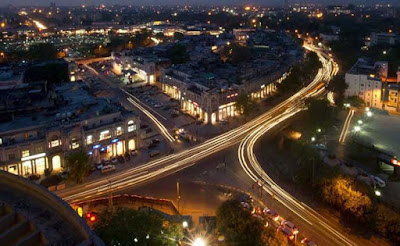 |
| Delhi |
Delhi, a true cosmopolitan city with diversified culture is the capital of the world’s largest democracy, India. Known as Indraprastha in ancient times, Delhi has been wooed by rulers, attracted invaders and has been build and destroyed several times. Historians say that is has been rebuilt seven times during different ages.The two worlds of the city, the Old and the New form a great synthesis and co-exist of modernity and traditions in a remarkable manner.New Delhi city is acclaimed for being the cultural capital of India. The spectacular architecture of Delhi city is evident through its antique monuments. This city witnesses an interesting blend of diverse cultures (some even 5000 years old).
Delhi has always had a mysterious eternity, the city having witnessed empires rise to glory and fall to ashes. The contemporary Delhi is a culmination of seven cities built by different emperors. Ruins of this ancient city are found even today and now these are converted to some major tourist attractions. Among some spectacular historic sites, the most prominent ones are: Qutub Minar, Red Fort, Jama Masjid, India Gate, Lotus temple, Humayun tomb and Rashtrapati Bhavan.
1.Attraction:
- India Gate and Rajpath:
 |
| India Gate |
India Gate is a memorial raised in honor of the Indian soldiers who died during the Afghan wars and World War I. 1 the names of the soldiers who died in these wars are inscribed on the walls. The cenotaph (or shrine) in the middle is constructed with black marble and depicts a rifle placed on its barrel, crested by a soldier's helmet.
- Sansad Bhavan:
 |
| Sansad Bhavan |
Sansad Bhavan or the Parliament of India is a circular building designed by the British architects Sir Edwin Lutyens and Sir Herbert Baker in 1912–1913. Construction began in 1921, and in 1927 the building was opened as the home of the Council of State, the Central Legislative Assembly, and the Chamber of Princes.
- Rashtrapati Bhavan:
 |
| Rashtrapati Bhavan |
Built with a mix of European and Mughal/Indian styles, Rashtrapati Bhavan was originally built for the Governor General of India. Inaugurated in 1931 as the Viceregal Lodge, the name was changed in 1959 after India became a republic. Now it is the Presidential Palace of India.
- Qutub Minar:
- Lodhi Gardens:
 |
| Lodhi Gardens |
Lodhi Gardens, once called
Lady Willingdon Park, laid out in 1930 this beautiful park contains 15th and
16th century monuments that are scattered among its well-kept lawns, flowers,
shady trees and ponds. During the early morning and evening hours, the
sprawling garden is a favourite spot for fitness freaks and those in search of
solitude.
2. Accomodation:
 |
| Hotel |
 |
| Hotel |
 |
| Hotel |
- Leela Kempinski,
- JW Marriot,
- The Lalit,
- Le Meridien,
- The Oberoi,
- The Taj Mahal,
- Hyatt Regency,
- The Park,
- Taj Palace Hotel,
- Imperial Hotel and many more.
 |
| Shopping Mall |
 |
| Shopping Mall |
DLF Emporio, Vasant Kunj,
DLF Promenade, Vasant Kunj,
Ansal Plaza, Hudco Place,
West Gate Mall,
Karol Bagh 3,
Paharganj,
Nehru Place,
Gandhi Nagar and many more.
4. Transport:
- By Air:
- By Rail:
Rail based transport in the city has started to gain
popularity with the introduction of Delhi Metro. Ring-Railway, which runs
parallel to the Ring-Road system is another rail-based intra-city transport
facility in Delhi.
- By Road:
Transportation is dependent
upon roads and railways, including rapid transit systems like Delhi Metro.
Roads in Delhi are maintained by Municipal Corporation of
Delhi (MCD), New Delhi MunicipalCouncil (NDMC), Delhi
Cantonment Board (DCB), Public Works Department (PWD) and Delhi
Development Authority (DDA). At 1749 km of road length per 100 km²,
Delhi has one of the highest road densities in India. Major roadways include
the Ring Road and the Outer Ring Road, which had a traffic density of 110,000
vehicles per day in 2001. Total road length of Delhi was 28,508 km
including 388 km of National Highways. Major road-based public transport
facilities in Delhi are provided by DTC buses, auto-rickshaws taxi sand
cycle-rickshaws.

No comments:
Post a Comment